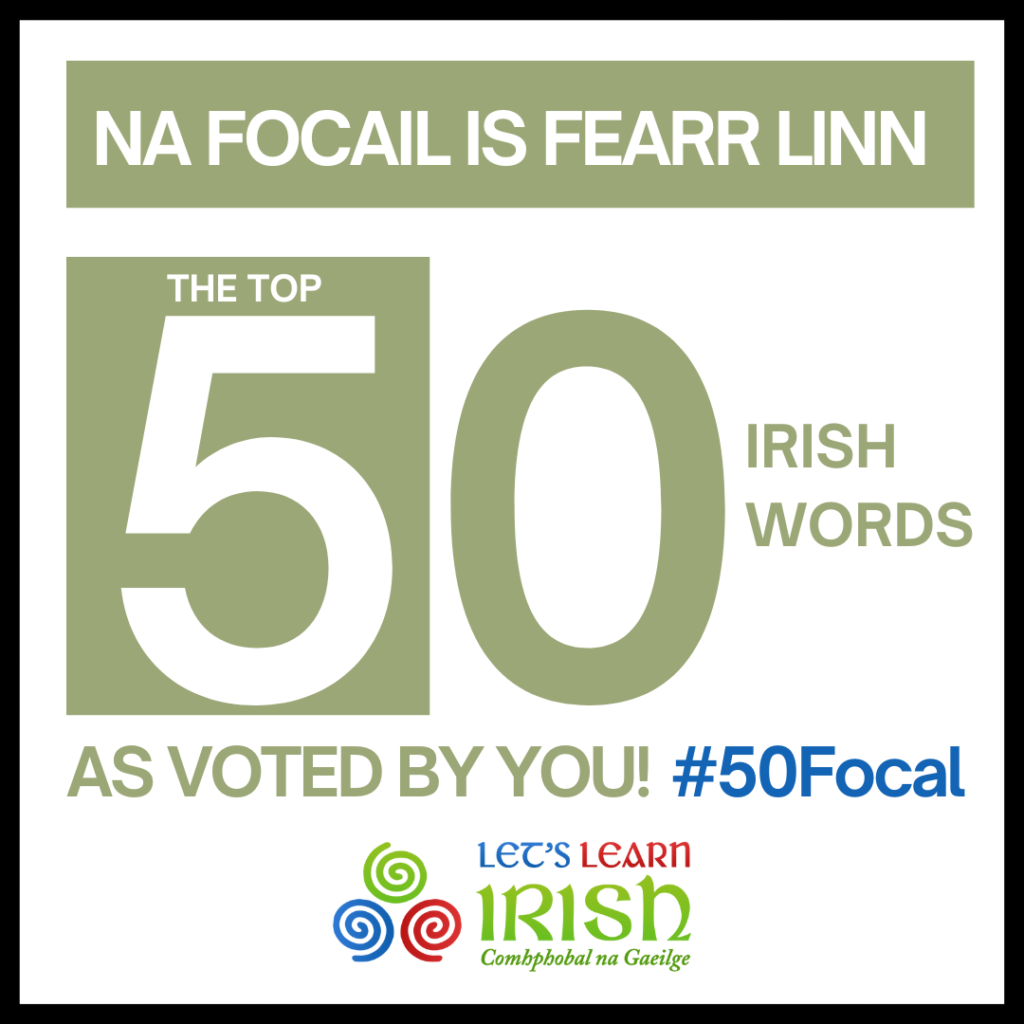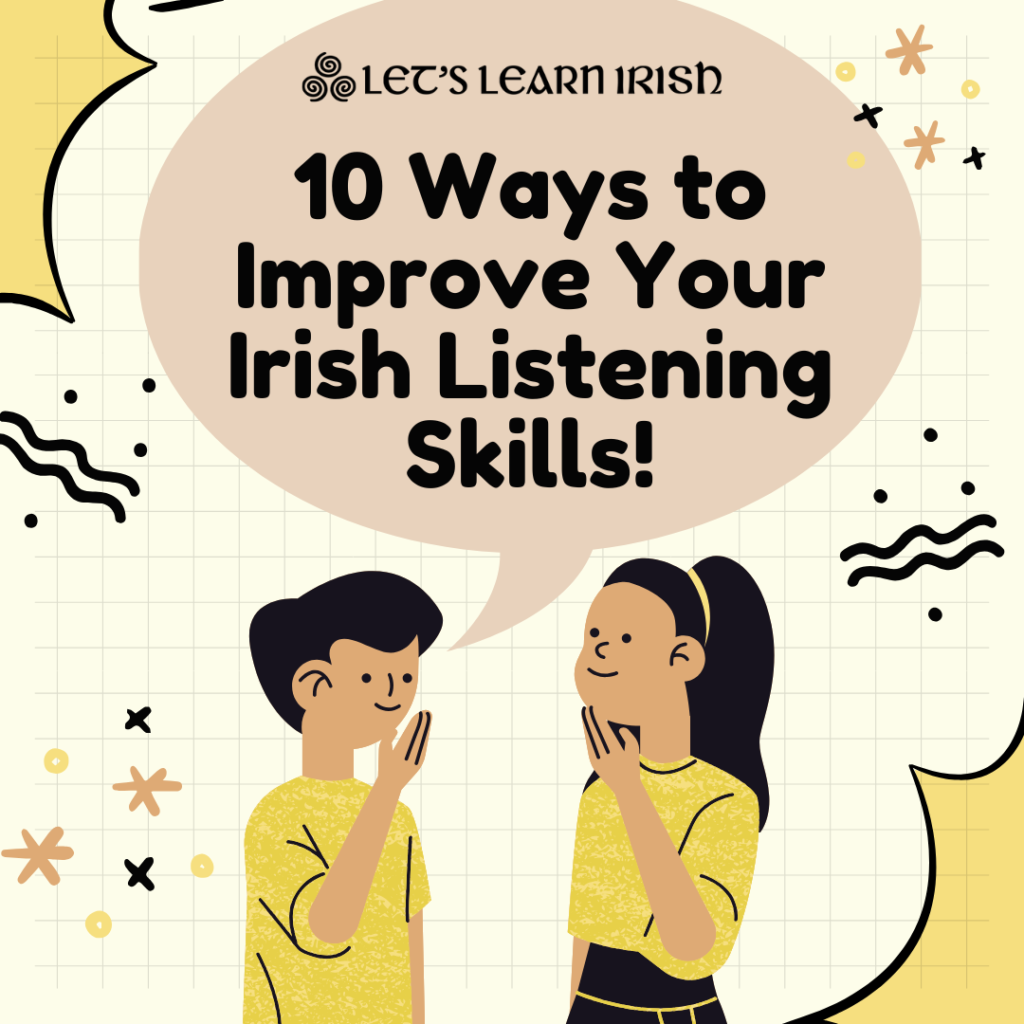Searching for Irish words – how to use Focloir.ie
In this video, we’re going to take a look at how to use the online English–Irish dictionary, focloir.ie, which was launched by Foras na Gaeilge in 2013. A concise, paper version of this dictionary was also published in 2020, but the online version has more entries and examples.
1. A Simple Search
First we’ll do a simple search. Remember that this is an English-to-Irish dictionary, so the search function is best designed for English search terms. Searching through Irish is also possible, but the results tend not be as well organised. Let’s search the English word ‘chair’.
 At the top of the entry we get a box summarising the different meanings. We need to pay close attention to the subject tags and definitions to make sure we pick an appropriate translation. We can see, for example, that if we’re looking for chair in the sense of ‘seat’ or ‘piece of furniture’, then cathaoir is an appropriate translation. However, if we’re looking for chair in the sense of ‘chairperson’, then cathaoirleach is the word we need.
At the top of the entry we get a box summarising the different meanings. We need to pay close attention to the subject tags and definitions to make sure we pick an appropriate translation. We can see, for example, that if we’re looking for chair in the sense of ‘seat’ or ‘piece of furniture’, then cathaoir is an appropriate translation. However, if we’re looking for chair in the sense of ‘chairperson’, then cathaoirleach is the word we need.
Next to each noun entry is a grammar tag (fem5 in the case of cathaoir, meaning a feminine noun of the fifth declension, and masc1 in the case of cathaoirleach meaning a masculine noun of the first declension). Don’t worry about the declensions for now, if you haven’t heard much about them before. The main thing to note here is that you can click on any of these grammar tags and see a pop-up summary of the singular and plural forms of that noun, in the nominative and genitive cases, with and without the definite article. Pretty neat!
But that’s not all. Many of the words on focloir.ie also have audio files, so you can listen to the pronunciation of the word in the Connacht, Munster and Ulster dialects.
2. Searching for a Verb
 Let’s try a verb next: for example, ‘prepare’. So, in the sense of ‘make something ready’ we get ullmhaigh, réitigh, and the verbal phrase déan réidh. Similarly to the nouns, we can view the different forms of a verb by clicking the little verb tag next to it. In the pop-up window we can see the verbal noun and adjective at the very top here, then we can select one of the tenses or moods and view all the different singular, plural and passive forms, as well as the interrogative and negative forms. And again, many of the entries have audio files, so we can listen to the pronunciation as well.
Let’s try a verb next: for example, ‘prepare’. So, in the sense of ‘make something ready’ we get ullmhaigh, réitigh, and the verbal phrase déan réidh. Similarly to the nouns, we can view the different forms of a verb by clicking the little verb tag next to it. In the pop-up window we can see the verbal noun and adjective at the very top here, then we can select one of the tenses or moods and view all the different singular, plural and passive forms, as well as the interrogative and negative forms. And again, many of the entries have audio files, so we can listen to the pronunciation as well.
We can also view grammar information for prepositions – for example, ‘with’ (or le in Irish) – and adjectives – for example, ‘cold’ (or fuar in Irish). You can see that there is a ton of grammar information hidden in the entries on focloir.ie, and now you know how to access it!
Searching for Idioms and Phrases
We can also search longer phrases, idioms and proverbs. Suppose we want to translate the phrase ‘to be at death’s door’ (in the sense of ‘being so ill that one might die’). If we search that, we get five Irish versions back: bheith ar leaba an bháis, bheith ar an dé deiridh, bheith ag saothrú an bháis, bheith ag comhrá leis an mbás, bheith sa déanach. Let’s try a proverb next; for example, if we search ‘silence is golden’, we get is binn béal ina thost.
So, next time you find yourself struggling to translate a common English phrase, idiom or proverb into Irish, search it here when you get a chance. More than likely you’ll find some nice Irish phrase you can use in its place.
An Advanced Search
 Okay, now we’re going to look at the ‘Advanced Search’ (hidden away up here below the main ‘Search’ button). Let’s search in Irish this time. If someone speaks a little bit of Irish, they might say they have cúpla focal, but how do you spell that again? Is it F-O-C-A-I-L or F-O-C-A-L? Let’s try the version with the I first. No matches found. And the version without the I? Aha, so now we know which version is correct. In fact, if we search only the word cúpla we can see that it is always followed by the singular: for example, cúpla duine, cúpla ceann, cúpla uair, cúpla babhta, and so on. Next time you’re unsure of something like this, run it through the ‘Advanced Search’ and see what kind of results you get. Maybe you’re not sure whether to add a séimhiú to the word Gaeilge in the phrase mo chuid Gaeilge. A quick search for both versions tells us that no séimhiú is needed.
Okay, now we’re going to look at the ‘Advanced Search’ (hidden away up here below the main ‘Search’ button). Let’s search in Irish this time. If someone speaks a little bit of Irish, they might say they have cúpla focal, but how do you spell that again? Is it F-O-C-A-I-L or F-O-C-A-L? Let’s try the version with the I first. No matches found. And the version without the I? Aha, so now we know which version is correct. In fact, if we search only the word cúpla we can see that it is always followed by the singular: for example, cúpla duine, cúpla ceann, cúpla uair, cúpla babhta, and so on. Next time you’re unsure of something like this, run it through the ‘Advanced Search’ and see what kind of results you get. Maybe you’re not sure whether to add a séimhiú to the word Gaeilge in the phrase mo chuid Gaeilge. A quick search for both versions tells us that no séimhiú is needed.
There’s a lot more that the ‘Advanced Search’ can do (like searching specifically for ‘vulgar’ words and phrases), but maybe it’s best not to get into that here! Take a look at the FAQ page if you’re interested to explore further. You can also find some useful PDFs about grammar, translation and different registers via the ‘Education’ page.
Conclusion
 That’s all for this video. I hope you learnt something.
That’s all for this video. I hope you learnt something.
Ádh mór leis an bhfoghlaim agus slán tamaillín a chairde!
For more tips and tricks, check out our video course, ‘Essential Tools for Learning Irish‘, where you will find 15 concise videos explaining how to use various online tools for learning Irish. You can also read about all the tools and learn tips by reading our article, Tools to Improve Your Irish Language Skills.
Bígí páirteach!
Join the online Irish community at LetsLearnIrish.com.
Follow on social media @LetsLearnIrish.





